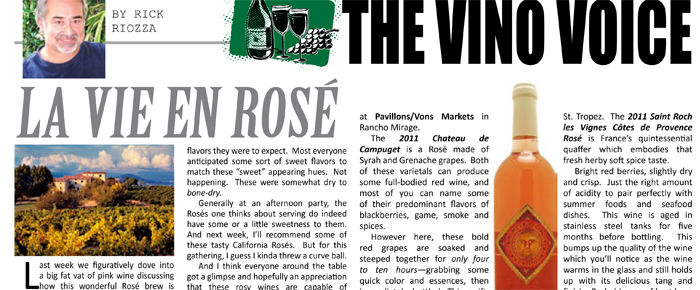
By Rick Riozza
Last week we figuratively dove into a big fat vat of pink wine discussing how this wonderful Rosé brew is experiencing a re-birth with vino lovers.
We wrote that the new “American palate” is now appreciating the Provençal style dry or non-sweet blush wine and that this type of Rosé is quite often the answer to wine-pairing woes: if you can’t decide between a white or a red for dinner, or, for that up-coming dinner party, well then the new drier-style Rosé is the choice whether you’re serving soup & salad, fish, poultry or meat.
Although “New World” Rosés are jumping in on producing a “less sweet” rosy wine, the world famous Rosés from Provence in the south of France have set the bar. That area gets us thinking of Van Gogh’s city of lively light—Arles, or, Marseille and their superlative fish bouillabaisse soup, or Renoir’s St. Tropez. The blush wines yielded here are generally—and wonderfully—dry , no matter how colorfully they are dressed in the bottle.
Recently we celebrated our family patriarch’s 85th birthday, John Ehrhardt—a retired minister who can still belt out a sermon. During the festivity we enjoyed a brief wine tasting where my son Paolo and I presented three French Provençal Rosés. Each bottle was robed in different shades of deep to light salmon, copper, and sunset-tinged glows.
I did my usual spiel of talking about the geography & wine making around the south of France, but I said nothing of the flavors they were to expect. Most everyone anticipated some sort of sweet flavors to match these “sweet” appearing hues. Not happening. These were somewhat dry to bone-dry.
Generally at an afternoon party, the Rosés one thinks about serving do indeed have some or a little sweetness to them. And next week, I’ll recommend some of these tasty California Rosés. But for this gathering, I guess I kinda threw a curve ball.
And I think everyone around the table got a glimpse and hopefully an appreciation that these rosy wines are capable of complexities to match the nuances of an assortment of meals and not simply a sweety-pie of a drink.
In fact, the two wines that were pretty dry, did pretty well as to approval and admiration. Some in the group were able to pick up the light & intriguing notes of herb, strawberry and melon along with stone and chalk minerality.
And truth be told, not everyone will enjoy a Provence Rose. The fruit flavors are mutted and huddled around an herby background. Those who regularly enjoy fruit-forward or touch- sweeter wines tend to find this blush as odd or even “off tasting”. However, those who find complexities in wine interesting, often catch these Rosés as very appealing—especially with appetizers or a meal on the table.
Now it’s time to get physical & practical and seek out a few good bottles of this wondrous blush and rosy—but dry wine. And of course, we’re always looking for the good deal to enjoy the remaining springtime and to cushion our rush into summer.
For those who wish to first experiment with a $6 Provence Rosé , checkout Trader Joe’s Côtes De Provence J.L. Quinson. Definitely an entry-level Rosé but for the price (after all, it is shipped in from France), when really chilled up, it is a fine example of how dry Rosés can taste.
It’s refreshing with soft strawberry and melon savors through an herby background. It’s flavorsome up front, but it does turns a bit metallic and dull in the finish if you’re not having a meal. That can be remedied by serving Greek-style cured olives.
For only around five dollars more you can jump into some really good Rosés that are excellently crafted and a great example of the Provençal style. The two wines we enjoyed can be found on sale at Pavillons/Vons Markets in Rancho Mirage.
The 2011 Chateau de Campuget is a Rosé made of Syrah and Grenache grapes. Both of these varietals can produce some full-bodied red wine, and most of you can name some of their predominant flavors of blackberries, game, smoke and spices.
However here, these bold red grapes are soaked and steeped together for only four to ten hours—grabbing some quick color and essences, then immediately bottled. This swift-style production should be experienced as it is a fun taste and be sure to keep this wine chilled as well.
The favorite Rosé of our tasting comes from the vineyards around St. Tropez. The 2011 Saint Roch les Vignes Côtes de Provence Rosé is France’s quintessential quaffer which embodies that fresh herby soft spice taste.
Bright red berries, slightly dry and crisp. Just the right amount of acidity to pair perfectly with summer foods and seafood dishes. This wine is aged in stainless steel tanks for five months before bottling. This bumps up the quality of the wine which you’ll notice as the wine warms in the glass and still holds up with its delicious tang and finish. Probably one of best buys while on sale for $11.
A tout a l’heure! Cheers!
Rick is the desert’s sommelier-about-town entertaining at wine events. Contact winespectrum@aol.com








































